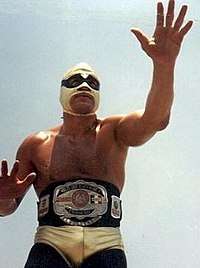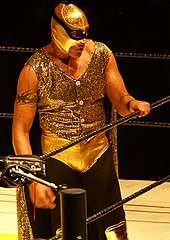El Solitario
Roberto González Cruz (May 22, 1946 – April 6, 1986) was a Mexican professional wrestler who wrestled under the name El Solitario.[1] During his career he held both the NWA World Light Heavyweight Championship and the NWA World Middleweight Championship. After achieving stardom in Mexico's oldest promotion, Empresa Mexicana de Lucha Libre, Gonzalez Cruz joined the breakaway promotion, the Universal Wrestling Association, where he held four more world championships in the early 1980s.
| El Solitario | |
|---|---|
 El Solitario in his trademark golden mask | |
| Birth name | Roberto González Cruz |
| Born | May 22, 1946 Yahualica, Jalisco, Mexico |
| Died | April 6, 1986 (aged 39) |
| Cause of death | Cardiac arrest |
| Professional wrestling career | |
| Ring name(s) | El Hijo del Santo El Solitario El Zica El Zica II Othon Banzica II |
| Trained by | Joe El Hermoso |
| Debut | 1960 |
Early life
Gonzalez Cruz came from a working-class family and was the youngest of seven children. At the age of twelve, his older brother Jesús, who was also a professional wrestler, began teaching him basic wrestling moves. In 1959, Gonzalez Cruz's brother was killed in the ring while wrestling as Othon Banzica, but rather than becoming deterred, Gonzalez Cruz drew inspiration from his death and dedicated himself to lucha libre. He began training under the tutelage of Joe el Hermoso and made his wrestling debut in 1960 at the age of fourteen.
Professional wrestling career
Gonzalez Cruz was initially billed as being the son of the legendary wrestler El Santo but later changed his name to El Zica II in honor of his deceased brother.
Gonzalez Cruz moved to Tijuana to pursue his career as a luchador but had a difficult time finding regular work as he was young and still small at the time. He continued working local arenas until he began making a name for himself as he grew physically and refined his wrestling skills. Cruz realized that in order to take his career to the next level, he would have to select a more crowd pleasing name and character. He chose the name El Solitario, derived from the popular comic book character El Llanero Solitario ("The Lone Ranger"'). He also adopted his now trademark gold and black colored costume and golden mask with a fringe around the eyes representing the Lone Ranger's mask. After the change, promoters and fans took notice of the new dynamic wrestler.
On November 16, 1965, El Solitario faced Panchito Ramirez in Arena Coliseo located in Guadalajara. He would make his debut in Arena Coliseo Mexico City on September 6, 1966, when he defeated Tony Reyna. In 1966, El Solitario defeated and unmasked Águila Tapatía, that was followed by a win over Mano Blanca. He won his first world title when he defeated Occident Welterweight champion Luís González.
El Solitario was now working for EMLL, Mexico's largest promotion company. He was catapulted into stardom within the lucha libre world when he defeated veteran Rey Mendoza in a mask vs hair match on December 13, 1968. A few weeks later, he defeated another legend, Rene Guajardo, and also took his hair in another wager match.
El Solitario formed a wrestling trio alongside Dr. Wagner and Angel Blanco; the group was known as "La Ola Blanca" (The White Wave). He was wrestling as a rudo at this time but when his partners Dr. Wagner and Angel Blanco turned on him, he became one of the most popular tecnicos of his era. It also started a legendary rivalry between himself, Wagner and Blanco. He continued wrestling as an individual during this time, and in 1969, won the NWA Middleweight world title by defeating El Rayo de Jalisco. In 1970, El Solitario won the NWA Light Heavyweight title by defeating Ray Mendoza. In 1972, he unmasked his rival, Angel Blanco, in the ring.
El Solitario was one of the first stars to leave EMLL to join the Universal Wrestling Association (UWA) promotion, which was run by Francisco Flores and Ray Mendoza. He won the UWA's first Junior Heavyweight title in 1982. He also toured Japan in 1972, 1979, and 1981, where he would face and team up with premiere stars such as Tiger Mask and Tatsumi Fujinami, along with other Mexican wrestlers such as Chavo Guerrero and El Canek. He was unable to fully exhibit his wrestling skills during his tours, as the junior's division formula in Japan consisted of popular Japanese wrestlers facing off against foreign heels. However, he gained a following outside of Mexico as a result of those tours.
While in Mexico, he remained one of the most popular headlining stars throughout the country. In the early 1980s, he formed a short lived trios team with Aníbal and Villano III, the group was known as Los Tres Caballeros that ended when Aníbal turned on El Solitario.[2] He won the UWA Junior Light Heavyweight title in 1980 and 1981. In 1982, he won the NWA Light Heavyweight title. That same year, he participated in El Santo's final career match when he teamed up with legends El Santo, Gory Guerrero, and Huracan Ramirez to defeat El Signo, Negro Navarro, El Texano, and Perro Aguayo.[3] Perhaps his biggest match took place on December 1, 1985, when he defeated and unmasked Dr. Wagner in a mask vs mask match.
Death

El Solitario had suffered injuries during the latter part of his career, resulting in several infections and illnesses. During a match with Fishman, he re-injured himself and was taken to the hospital while complaining of abdominal pain. His doctors initially misdiagnosed his condition, and it was later discovered that he was suffering from internal bleeding that required immediate surgery. On April 6, 1986, at the age of 39, El Solitario died while on the operating table as a result of a cardiac arrest.[4]
Although El Solitario's life was fairly short, his professional career spanned over twenty-five years and he is regarded as one of the greatest Mexican professional wrestlers of all time.[5] He was inducted into the Wrestling Observer Newsletter Hall of Fame in 1996.
His son, El Hijo del Solitario, made his wrestling debut in 1990.
Championships and accomplishments
- Empresa Mexicana de Lucha Libre
- Universal Wrestling Association
- Wrestling Observer Newsletter awards
Lucha de Apuesta record
| Winner (wager) | Loser (wager) | Location | Event | Date | Notes |
|---|---|---|---|---|---|
| El Solitario (mask) | Karloff Lagarde (hair) | N/A | Live event | N/A | |
| El Solitario (mask) | Coloso Colosetti (hair) | Mexico City | Live event | N/A | |
| El Solitario (mask) | César Valentino (hair) | Mexico City | Live event | N/A | |
| El Solitario (mask) | Alfonso Dantés (hair) | Mexico City | Live event | N/A | |
| El Solitario (mask) | Águila Tapatía (mask) | Guadalajara, Jalisco | Live event | 1966 | |
| El Solitario (mask) | The White Hand (mask) | Guadalajara, Jalisco | Live event | June 17, 1966 | |
| El Solitario (mask) | Luis González (hair) | Mexico City | Live event | July 1966 | |
| El Solitario (mask) | Ray Mendoza (hair) | Mexico City | Live event | December 13, 1968 | |
| El Solitario (mask) | René Guajardo (hair) | Mexico City | Live event | December 25, 1968 | |
| El Solitario (mask) | David Morgan (hair) | Mexico City | Live event | April 7, 1972 | |
| El Solitario (mask) | Ángel Blanco (mask) | Mexico City | Live event | December 8, 1972 | [7] |
| El Solitario (mask) | Ángel Blanco (hair) | Guadalajara, Jalisco | Live event | February 3, 1974 | [7] |
| El Solitario (mask) | El Cardenal (mask) | Monterrey, Nuevo León | Live event | March 2, 1975 | |
| El Solitario (mask) | Atila (mask) | Mexico City | Live event | November 19, 1975 | |
| El Solitario (mask) | Destroyer (mask) | Juárez, Chihuahua | Live event | December 5, 1975 | |
| El Solitario (mask) | El Audaz (mask) | Mexico City | Live event | April 12, 1976 | [Note 1][8] |
| El Solitario (mask) | Ku Klux Klan (mask) | Mexico City | Live event | February 9, 1977 | |
| El Solitario (mask) | Perro Aguayo (hair) | Mexico City | Live event | September 10, 1978 | [9] |
| El Solitario (mask) | Máscara Roja (mask) | N/A | Live event | September 24, 1978 | [10] |
| El Solitario (mask) | Bestia Roja (mask) | N/A | Live event | November 25, 1979 | |
| El Solitario (mask) | Nakamura (mask) | Tijuana, Baja California | Live event | March 25, 1981 | |
| El Solitario (mask) | El Faraón (hair) | Guadalajara, Jalisco | Live event | April 6, 1981 | |
| El Solitario (mask) | El Olímpico | Mexico City | Live event | June 20, 1982 | [11] |
| El Solitario (mask) | El Signo (hair) | Tijuana, Baja California | Live event | June 12, 1983 | |
| El Solitario (mask) | Dr. Wagner (mask) | Monterrey, Nuevo León | Live event | December 1, 1985 |
Notes
- Lost a Relevos Suicidas match vs. Aníbal and Rayo de Jalisco
References
- General sources – Championship Information
- Royal Duncan & Gary Will (2000). "Mexico". Wrestling Title Histories. Archeus Communications. pp. 389–402. ISBN 0-9698161-5-4.
- General sources – Career
- Madigan, Dan (2007). "Los Enmascarados (the masked men): El Solitario". Mondo Lucha A Go-Go: the bizarre& honorable world of wild Mexican wrestling. HarperColins Publisher. pp. 106–110. ISBN 978-0-06-085583-3.
- "El Solitario". Lucha Libre: Masked Superstars of Mexican Wrestling. Distributed Art Publishers, Inc. 2005. pp. 28–36. ISBN 968-6842-48-9.
- "Furia Azul contra Capucha Dorada / the Blue Fury versus the golden hood". Lucha Libre: Masked Superstars of Mexican Wrestling. Distributed Art Publishers, Inc. 2005. pp. 38–51. ISBN 968-6842-48-9.
- "Lucha Libre: Conoce la historia de las leyendas de cuadrilátero". Solitario (1946–1986) (in Spanish). Mexico. 2008. p. 57. Grandes Figuras de la Lucha Libre.
- Specific
- Molinaro, John F.: Top 100 Pro Wrestlers of All Time, page 158, Winding Stair Press, 2002.
- Centinella, Teddy (June 29, 2015). "En un día como hoy… 1980: René Guajardo rapa al Perro Aguayo… 2009: La Parkita y Espectrito II son asesinados". Súper Luchas (in Spanish). Retrieved June 29, 2015.
- http://www.lethalwrestling.com/opinions/news_content.php?fileName=756
- "Archived copy". Archived from the original on 2008-12-07. Retrieved 2008-12-27.CS1 maint: archived copy as title (link)
- Madigan, Dan (2007). "Los Enmascarados (the masked men): El Solitario". Mondo Lucha A Go-Go: the bizarre& honorable world of wild Mexican wrestling. HarperColins Publisher. pp. 106–110. ISBN 978-0-06-085583-3.
- "El Solitaro". Online World of Wrestling.
- "Enciclopedia de las Mascaras". Ángel Blanco (in Spanish). Mexico. July 2007. p. 14. Tomo I.
- "Enciclopedia de las Mascaras". Audaz (in Spanish). Mexico. July 2007. p. 26. Tomo I.
- "Luchas 2000". Perro Aguayo y sus Victimas (in Spanish). Juárez, Mexico: Publicaciones citem, S.A. de C.V. pp. 12–15. Especial 30.
- "Enciclopedia de las Mascaras". Máscara Roja (in Spanish). Mexico. October 2007. p. 26. Tomo III.
- "Enciclopedia de las Mascaras". Olímpico (Segunda version) (in Spanish). Mexico. October 2007. p. 45. Tomo III.